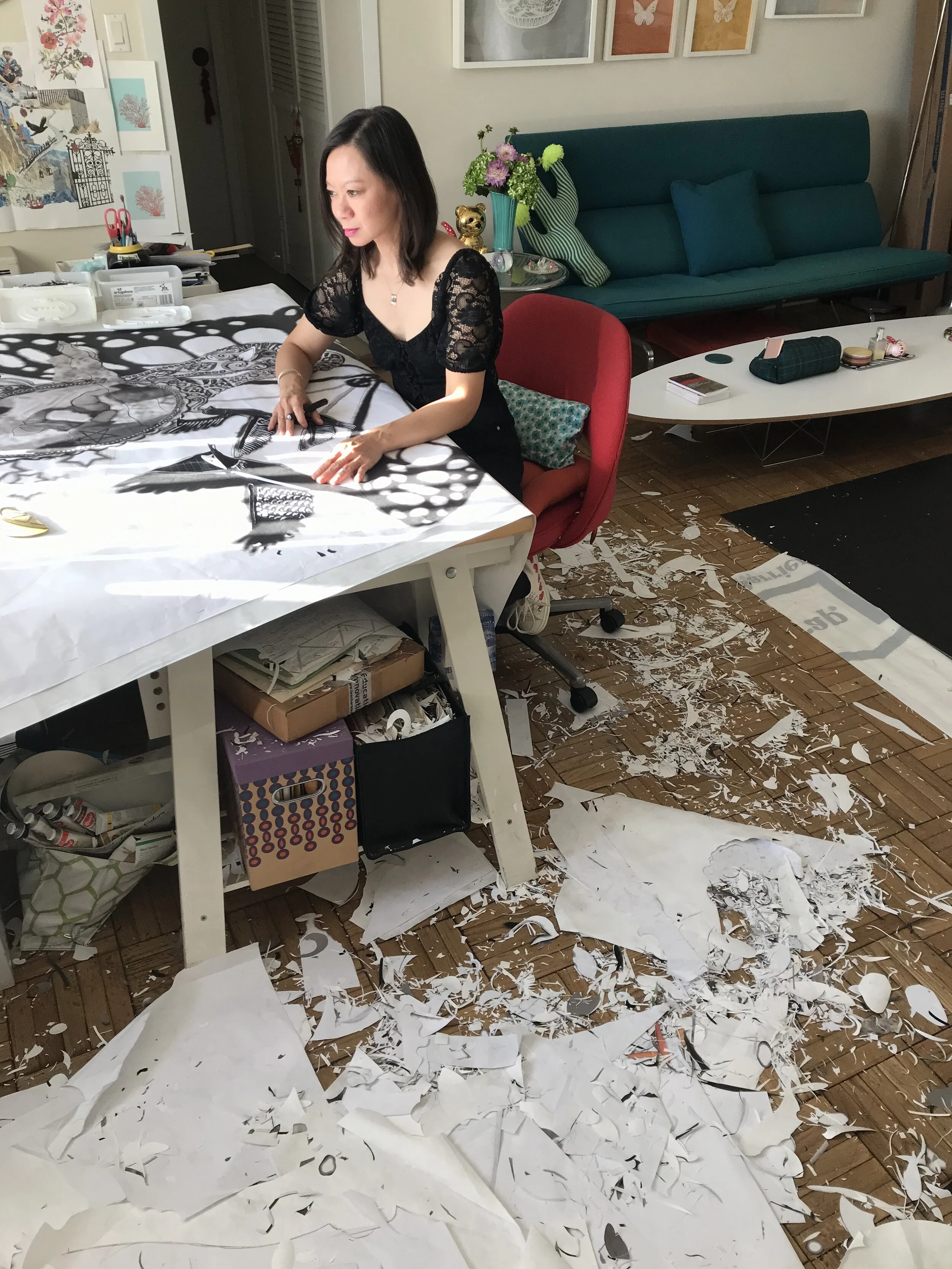
Statement
Departure and Arrival
My cut paper work explores the concepts of departure and arrival in the context of the diasporic self and communities, and our collective divergence from nature to the urbanized world. It all began with my own migration from Hong Kong to America. My earliest works mined my personal history, using images of Chinese architecture, symbols, and landscapes to explore my position as a Chinese woman in the U.S. These works sought to reconcile notions of my old and new self, and to bridge these two identities into a more authentic reflection of who I am.
As I explored my place in the world, I became fascinated by my physical space, especially as it pertained to the natural world. Nature is something we fantasize about and desire, while at the same time colonizing it through relentless urbanization. My work began to incorporate images of nature alongside the man-made constructs that were destroying it — from busy highways to towering skyscrapers — looking at how we depart from the natural to the built world, despite our innate desire for the former.
Ideas of departure and arrival became all the more significant and urgent as we saw increasingly heated debate regarding the border and the position of the immigrant in America. In many ways this signaled a return to my earliest works, reflecting on migration and the diaspora, but now in the context of the public discourse. My work became populated with motifs of stars, gates, tiaras, fences, and oceans, often still drawing on my personal migration, but now tied to a much broader communal issue.
Throughout all of these works the idea of community remains central. From the way migration disperses one’s community, to how our destruction of nature in favor of urbanization has shifted us away from communal to individual living. We are constantly departing and arriving, forcing us to negotiate a tenuous and ever-changing balance with ourselves, with our community, and with our natural world.
The very medium that my cut paper practice centers around is inspired by the generational and communal art of Chinese paper cutting. While the practice of communal paper cutting has largely disappeared, my use of Xuan (rice) paper continues to tie me to that tradition, and to ground me in that connection to both my ancestors and contemporaries.
Drawing with a knife
I create most of my works on Xuan (rice) paper, which reflects my Chinese heritage and my earliest encounters with art making as a child, which began with Chinese calligraphy, painting, and drawing. In one sense, my practice is a natural extension of those earlier forms; I think of cut paper as drawing with a knife and, like calligraphy and painting, cut paper draws on the same interplay between solid and void, immediacy and permanence to create a visual form.
Photo by Dominic Nieri courtesy Meta
Inspired by generations of women
My cut paper practice is also a nod to my ancestral roots, and is very much informed by traditional Chinese paper cutting. Historically, paper cutting in China was a pastime done communally by generations of women. The works, which were often created in multiples at the same time, responded to the women’s everyday lives and often depicted images of farm and village life. Though these works required skill, unlike the recognition given to calligraphers or landscape artists, the final product would always be anonymous.
Like these women, I too am reflecting on my contemporary experience, it is just vastly different from the world they encountered. Unlike them, I am able to create something that expresses my individuality, and reflects my social and political views in my work through one-of-a-kind, concept driven works that elevate a traditional craft to a fine art practice. It is important to me to acknowledge the roots of this practice, while at the same time reinventing the art form, and creating something that is radically different and distinctly contemporary.
Incorporating technology as a means
With these works, I also drift from the traditional practice by incorporating technology into my process. I first create a template on my computer, which I make by layering hundreds of images together into collage form. I then use that composite image as a guide as I cut the final work. While I do use the computer during part of my process, and often source images from the Internet, it is very important to me that the actual cutting is done by hand. With the advent of technology we have become so removed from craftsmanship that it is almost inconceivable to many people that one would create such intricate and labor-intensive works by hand.
Return to hand craftsmanship
People often ask if my works are cut by laser, but in fact, a laser could not create something nearly as precise and detailed as my final works. I am very interested in our acquiescence to technology, and our societal lack of belief in our own skill. To me, there is so much value in the return to craftsmanship, and the need to handle and work with materials directly.
Into the brave new world
In the Post-Information age, we further pursue experience in digitally intelligent spaces and attempt planetary colonization. Where would paper go next? I am interested in taking cut paper, a tactile art form, into the virtual realm. Since 2022, I have embarked on new creative exploration with 3D animation and augmented reality installation derived from my original hand cut paper works. I believe the advent of exciting new technologies can expand the expressions of cut paper in ways that are at once complex, relevant, and fresh.

